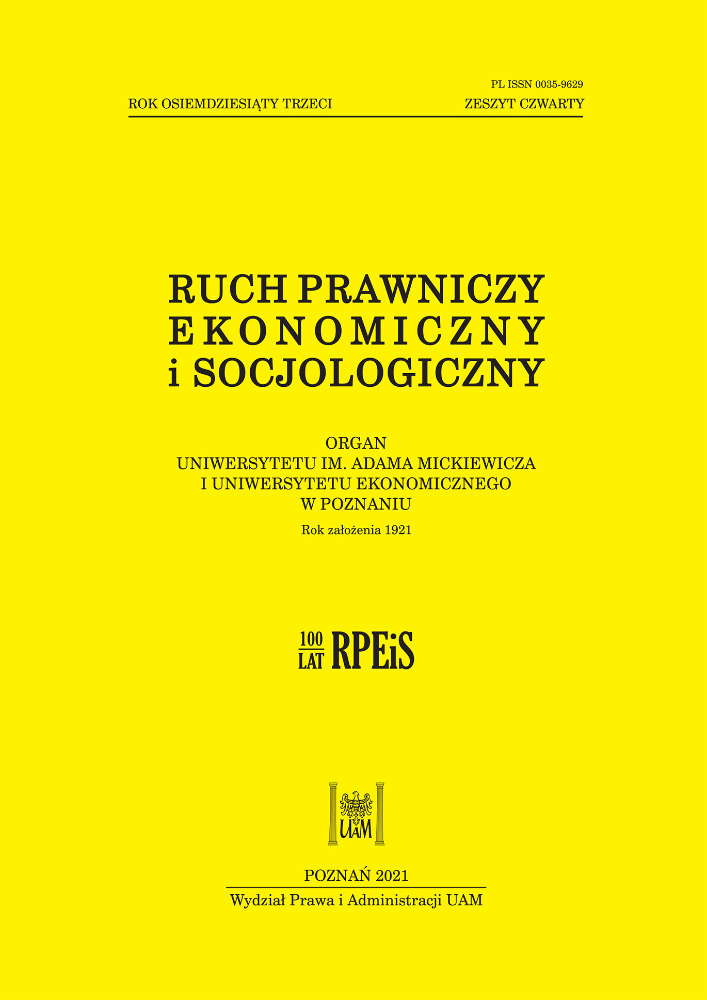Abstract
Preventive measures are to achieve two objectives, which are linked to two basic functions of these measures. One of them is strictly procedural, while the second detaches itself from the subject of the trial and allows for the exceptional use of a preventive measure in order to protect against committing a new, serious crime belonging to the catalog of crimes against life, health or public safety. These premises are common to pre-trial detention and other non-custodial preventive measures, which are significantly different in terms their essence. In the author’s opinion, such a situation does not correspond to reality and, as it introduces inconsistencies in the system of these measures, change is necessary. Hence, the purpose of this text is to consider the legitimacy of a review of the grounds for applying non-custodial preventive measures as significantly different from pre-trial detention. The text is intended to stimulate a debate on the shape and further direction of the development of non-voluntary preventive measures as a non-liberal and more effective alternative to the abused pre-trial detention. The research method is the dogmatic and formal method, based on an analysis of the literature on the subject and the text of legal acts. The author concludes that the proposed change seems to correspond to the trends of the last quarter of a century, expanding the catalog of these coercive measures to include many freedom measures, which, contrary to the systemic assumption, perform the preventive function as the basic one. It also introduces consistency between the specific premises of individual preventive measures and the general declaration of Article 249 § 1 and the premises of Article 258 § 3 Code of Criminal Procedure. And it makes the procedural organs more flexible as regards the protection of entities at risk of further criminal activity of the accused.
References
Dudek, D. (1999). Konstytucyjna wolność człowieka a tymczasowe aresztowanie. Lublin.
Fredrich-Michalska, I., Stachurska-Marcińczak, B. (1997). Uzasadnienie rządowego projektu kodeksu postępowania karnego, [w:] Nowe kodeksy karne z 1997 r. z uzasadnieniami. Warszawa.
Grzegorczyk, T., Tylman, J. (2011). Polskie postępowanie karne. Warszawa.
Jarząbek, K. (2019) Zakaz ubiegania się o zamówienia publiczne na czas trwania postępowania w świetle systemu środków zapobiegawczych. Monitor Prawniczy 16: 890–897.
Karaźniewicz, J. (2018). Zakres prewencyjnego stosowania środków przymusu procesowego – próba oceny tendencji rozwojowych, [w:] S. Steinborn, K. Woźniewski (red.), Proces karny w dobie przemian. Zagadnienia ogólne. Gdańsk: 541–558.
Karlik, P. (2016). Poręczenie majątkowe w polskim procesie karnym. Warszawa.
Kosonoga, J. (2005). Funkcje środków zapobiegawczych. Wojskowy Przegląd Prawniczy 4: 111–127.
Kosonoga, J. (2008) Dozór Policji jako środek zapobiegawczy w polskim procesie karnym. Warszawa.
Kruszyński, P. (1999). Tymczasowe aresztowanie, [w:] P. Kruszyński (red.), Nowe uregulowania prawne w kodeksie postępowania karnego z 1997 r. Warszawa: 221–244.
Mogilinicki, A. (1933). Kodeks postępowania karnego. Komentarz. Kraków.
Skorupka, J. (2020). Proces karny. Warszawa.
Stefański, R.A., Zabłocki, S. (2019). Kodeks postępowania karnego. Tom 2: Komentarz do art. 167–296. Warszawa.
Stefański, R.A. (1998). Środki zapobiegawcze w nowym kodeksie postępowania karnego. Warszawa.
Szumski, A. (2012). Funkcja prewencyjna tymczasowego aresztowania. Prokuratura i Prawo 7/8: 139–147.
Świda, Z. (2002). Podstawy i tryb stosowania tymczasowego aresztowania w świetle reguł prawa międzynarodowego, obowiązującego kodeksu postępowania karnego i projektu zmian kodeksu postępowania karnego z 2000 r., [w:] S. Stachowiak (red.), Współczesny polski proces karny.
Księga ofiarowana Profesorowi Tadeuszowi Nowakowi. Poznań: 175–188.
Tarnowska, D. (2002). Pozaprocesowa funkcja środków zapobiegawczych. Prokuratura i Prawo 11: 71–80.
Trzcińska, A., Wiliński, P. (2005). Tymczasowe aresztowanie w świetle Konwencji o ochronie praw człowieka i podstawowych wolności oraz Międzynarodowego Paktu praw obywatelskich i politycznych, [w:] E. Dynia, C.P. Kłak (red.), Europejskie standardy ochrony praw człowieka a ustawodawstwo polskie. Rzeszów: 251–262.
Waltoś, S., Hofmański, P. (2018). Proces karny. Zarys system. Warszawa.
License
Copyright (c) 2021 WPiA UAM

This work is licensed under a Creative Commons Attribution-NonCommercial-NoDerivatives 4.0 International License.





